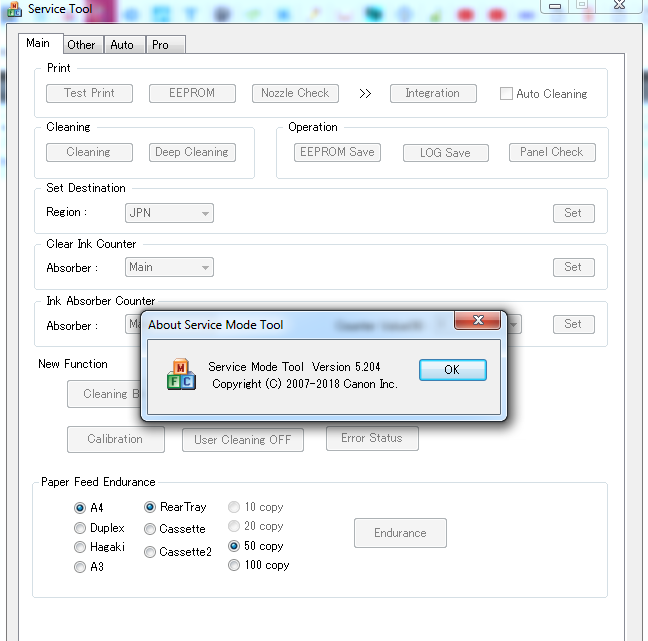Servisnuyu Programmu General Tool Dlya Canon Ip1900

Opmanager license file crack phn. • The new Cisco AnyConnect Secure Mobility client licensing fully explained. • Remote Desktop Manager is a remote connection and password management platform for IT pros trusted by more than 300 000 users in 130 countries.
Sep 30, 2017 - To reset the Canon iP1900, iP1980 can be done with (select one). General Tool v1.03. Service Tool av.300. Service Tool av.700. CANON MP190 PRINTING CISS. CANON MP190 PRINTING CISS. CANON MP190 PRINTING CISS.
Description: A common business model for inkjet printers involves selling the actual printer at or below production cost,[14] while dramatically marking up the price of the (proprietary) ink cartridges (a model called 'Freebie marketing'). All current inkjet printers attempt to enforce this product tying using microchips in the cartridges to hinder the use of third-party or refilled ink cartridges. The microchips monitor usage and report the ink remaining to the printer. Some manufacturers also impose Expiration dates.
When the chip reports that the cartridge is empty (or out of date) the printer stops printing. Even if the cartridge is refilled, the microchip will indicate to the printer that the cartridge is depleted. Many models (especially from Canon) the 'empty' status can be overridden by entering a 'service code' (or simply by pressing the 'start' button again). For some printers, special circuit flashers are available that reset the quantity of remaining ink to the maximum.
Some manufacturers, most notably Epson and Hewlett Packard, have been accused of indicating that a cartridge is depleted while a substantial amount of ink remains.[15][16] A 2007 study found that most printers waste a significant quantity of ink when they declare a cartridge to be empty. Single-ink cartridges were found to have on average 20% of their ink remaining, though actual figures range from 9% to 64% of the cartridge's total ink capacity, depending on the brand and model of printer.[17][18] This problem is further compounded with the use of multi-ink cartridges, which are declared empty as soon as one color runs low. Of extreme annoyance to many users are the printers that refuse to print in B&W when (only) one of the colors is depleted. Description: Features An interesting feature of this processor is that it was the first x86 processor with protected mode.
Protected mode enabled up to 16 MB of memory to be addressed by the on-chip linear memory management unit (MMU) with 1 GB logical address space. The MMU also provided protection from (crashed or ill-behaved) applications writing outside their allocated memory zones. By design, the 286 could not revert from protected mode to the basic 8086-compatible 'real mode' without a hardware-initiated reset.
• PIN security management equal to the original SIM. Sim emu 601 configurator v21 free. Supported Models: • The new features and improvements introduced were: • Support of up to 10 distinct numbers of distinct operators simultaneously.

In the PC-AT, IBM added external circuitry as well as specialized code in the ROM BIOS to enable special series of program instructions to cause the reset, allowing real-mode reentry (while retaining active memory and control). Though it worked correctly, the method imposed a huge performance penalty. Description: -- Miranda B Camera (S/N 581xxx) -- 1957-19?? -- Miranda 50mm f/1.9 -- PAD lens, chrome (S/N Y 128xx) -- Eye-level pentaprism finder Body weight = 657g (with finder) Taken with a Canon T2i/550D and Canon 100mm f/2.8 Macro lens at f/5.6. 62 1/30-second exposures at ISO100 in a focus stack (DoF stack) were combined with Zerene Stacker using DMap mode. Shooting was done tethered to a PC using the Canon EOS utility.
Focus stepping was done by pressing the live view '>' focus button once between each exposure in the stack. Description: -- Miranda C Camera (S/N 603xxx) -- 1959-19?? -- Soligor Miranda 50mm f/1.9 -- PAD lens, black (S/N Y 144xx) -- Eye-level pentaprism finder Body weight = 681g (with finder) Taken with a Canon T2i/550D and Canon 100mm f/2.8 Macro lens at f/5.6. 62 1/30-second exposures at ISO100 in a focus stack (DoF stack) were combined with Zerene Stacker using DMap mode. Shooting was done tethered to a PC using the Canon EOS utility.